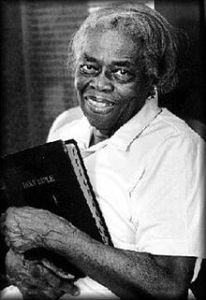February is Black History Month. Frankly, I don’t like the occasion.
Let me explain.
We should not need a special month to recognize and celebrate Black History. We should learn Black History every month. For that matter, we as Americans should spend more time learning history in general. We would benefit by learning more of our history, with its complexity and diversity. The insights, perspectives, and inspiration of studying history are invaluable and provide much needed context for current events.
Now, since it is Black History Month, I want to share the true story of an amazing philanthropist who died 20 years ago. Her tale demonstrates the power of philanthropy, the value of solid donor stewardship, and the important partnerships that financial advisors and development professionals can form to serve donors better. I first presented this story in my award-winning book, Donor-Centered Planned Gift Marketing:
Oseola McCarty was a quiet, 87-year-old African-American woman living in Haittesburg, Mississippi. Even as a young child, she worked and she saved.

Oseola McCarty
“I would go to school and come home and iron. I’d put money away and save it. When I got enough, I went to First Mississippi National Bank and put it in. The teller told me it would be best to put it in a savings account. I didn’t know. I just kept on saving,” McCarty said.
Unfortunately, when McCarty was in the sixth grade, her childless aunt became ill. McCarty left school to care for her and never returned to school. Instead, she spent a lifetime earning a living by washing and ironing other people’s clothes. And, she continued to save what she could by putting money into several local banks. She worked hard, lived frugally, and saved.
Nancy Odom and Ellen Vinzant of Trustmark Bank worked with McCarty for several years, not only helping her manage her money but helping look after her personally. They eventually referred her to Paul Laughlin, Trustmark’s assistant vice president and trust officer. “In one of our earliest meetings, I talked about what we could do for her,” Laughlin said. “We talked about providing for her if she’s not able. Then, we turned naturally to what happens to her estate after she dies.”
Laughlin continued, “She said she wanted to leave the bulk of her money to Southern Miss, and she didn’t want (anybody) to come in and change her mind. I called Jimmy Frank McKenzie, her attorney—she’d done laundry for him for years—and he talked to her. He made sure it was her idea. Then, I met with her to let her decide how to divide her money up.”
McCarty said, “Mr. Paul laid out dimes on the table to explain how to divide it up.”
Laughlin explained, “I got 10 dimes (to represent percentages). I wrote on pieces of paper the parties she wanted to leave her money to and put them on the table. Then, I asked how she wanted her money to be split up. She put one dime on her church and one each for several relatives. Then, she said she wanted the rest—six dimes—to go to the college. She was quite definite about wanting to give 60 percent to Southern Miss. To my knowledge, she had never been out there, but she seems to have the best of the students in mind. The decision was entirely hers.”
McCarty said, “I just want the scholarship to go to some child who needs it, to whoever is not able to help their children. I’m too old to get an education, but they can.”
McCarty signed an irrevocable trust agreement stating her wishes for her estate and giving the bank the responsibility for managing her funds. “Mr. Paul gives me a check, and I can go get money anytime I need it. My lawyer gave them permission to take care of me if something happens to me,” McCarty said.
Laughlin said the bank normally keeps such transactions in strictest confidence, but because of the uniqueness of McCarty’s story, he asked for her permission to make it public. “Well, I guess that would be all right,” she said with her typical calm acceptance.
Laughlin notified The University of Southern Mississippi in 1995. McCarty, a washerwoman for over 75 years, donated $150,000 to Southern Miss to establish the endowed Oseola McCarty Scholarship. Southern Miss recognized McCarty’s generosity, and she finally got to see the university. She also got to meet some scholarship recipients before her death in 1999.
As a result of the publicity about her extraordinary gift, Southern Miss raised over $200,000 in current gifts for the Oseola McCarty Scholarship Fund, which allowed for the immediate awarding of scholarships. By working together, McCarty’s advisors—her bankers and her lawyer—were able to protect her interests and assist her in realizing her philanthropic aspirations.
Without the wisdom of the advisors, the gift to Southern Miss might never have been. Or, if it had been made, might not have been done in a way that would give the donor so much joy and the university the opportunity to leverage the story. By working together, advisors and nonprofit officials were able to ensure that McCarty’s wishes were honored, and that she was appropriately recognized while still alive, bringing her much deserved joy.
With McCarty’s story, Southern Miss was also able to inspire others to be philanthropic. Students benefited sooner, and more students have benefited than otherwise may have been the case.
[Note: This story was compiled with material from the Oseola McCarty page at The University of Southern Mississippi web site.]
What inspirational stories about African-American philanthropy can you share? Do you have any stories about how a meaningful relationship with a financial advisor has benefited a donor and your organization? If you have a tale, I invite you to share it below.
That’s what Michael Rosen says… What do you say?








